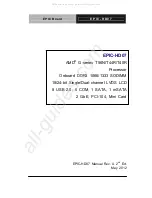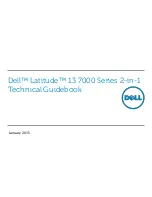
Document # 001-20559 Rev. *D
277
Digital Clocks
25.1.3
32.768 kHz Crystal Oscillator
The PSoC may be configured to use an external crystal. The
crystal oscillator is discussed in detail in the chapter
nal Crystal Oscillator (ECO)” on page 21
25.1.4
External Clock
The ability to replace the 24 MHz internal main oscillator
(IMO), as the device master system clock (SYSCLK) with an
externally supplied clock, is a feature in the PSoC device
(see
Pin P1[4] is the input pin for the external clock. This pin was
chosen because it is not associated with any special fea-
tures such as analog IO, crystal, or In System Serial Pro-
gramming (ISSP). It is also not physically close to either the
P1[0] and P1[1] crystal pins. If P1[4] is selected as the exter-
nal clock source, the Drive mode of the pin must be set to
High Z (not High Z analog).
The user is able to supply an external clock with a frequency
between 1 MHz and 24 MHz. The reset state of the EXT-
CLKEN bit is ‘0’; and therefore, the device always boots up
under the control of the IMO. There is no way to start the
system from a reset state with the external clock.
When the EXTCLKEN bit is set, the external clock becomes
the source for the internal clock tree, SYSCLK, which drives
most PSoC device clocking functions. All external and inter-
nal signals, including the 32 kHz clock, whether derived
from the internal low speed oscillator (ILO) or the crystal
oscillator, are synchronized to this clock source.
Note that there is no glitch protection in the device for an
external clock. Ensure that the external clock is glitch-free.
See device datasheet for the clock specifications.
25.1.4.1
Clock Doubler
One of the blocks driven by the system clock is the clock
doubler circuit that drives the SYSCLKX2 output. This dou-
bled clock, which is 48 MHz when the IMO is the selected
clock (at 24 MHz), may be used as a clock source for the
digital PSoC blocks. When the external clock is selected, the
SYSCLKX2 signal is still available and serves as a doubler
for whatever frequency is input on the external clock pin.
Following the specification for the external clock input
ensures that the internal circuitry of the digital PSoC blocks,
which is clocked by SYSCLKX2, meets timing requirements.
However, since the doubled clock is generated from both
edges of the input clock, clock jitter is introduced if the duty
cycle deviates greatly from 50 percent. Also, the high time of
the clock out of the doubler is fixed at 21 ns, so the duty
cycle of SYSCLKX2 is proportional to the inverse of the fre-
quency, as shown in
. Regardless of the input
frequency, the high period of SYSCLKX2 is 21 ns nominal.
Figure 25-2. Operation of the Clock Doubler
25.1.4.2
Switch Operation
Switching between the IMO and the external clock may be
done in firmware at any time and is transparent to the user.
Since all PSoC device resources run on clocks derived from
or synchronized to SYSCLK, when the switch is made, ana-
log and digital functions may be momentarily interrupted.
Switch timing depends on whether the CPU clock divider is
set for divide by 1, or divide by 2 or greater. In the case
where the CPU clock divider is set for divide by 2 or greater,
as shown in
, the setting of the EXTCLKEN bit
occurs shortly after the rising edge of SYSCLK. The SYS-
CLK output is then disabled after the next falling edge of
SYSCLK, but before the next rising edge. This ensures a
glitch-free transition and provides a full cycle of set up time
from SYSCLK to output disable. Once the current clock
selection is disabled, the enable of the newly selected clock
is double synchronized to that clock. After synchronization,
on the subsequent negative edge, SYSCLK is enabled to
output the newly selected clock.
In the 24 MHz case, as shown in
, the assertion
of IOW_ and thus the setting of the EXTCLKEN bit occurs
on the falling edge of SYSCLK. Since SYSCLK is already
low, the output is immediately disabled. Therefore, the set
up time from SYSCLK to disable is one-half SYSCLK.
Extenal Clock
SYSCLKX2
21 ns Nominal
Содержание PSoC CY8C23533
Страница 4: ...Contents Overview 4 Document 001 20559 Rev D Section G Glossary 385 Index 401 ...
Страница 16: ...Contents Overview 16 Document 001 20559 Rev D ...
Страница 24: ...24 Document 001 20559 Rev D Section A Overview ...
Страница 30: ...30 Document 001 20559 Rev D Pin Information ...
Страница 54: ...54 Document 001 20559 Rev D Supervisory ROM SROM ...
Страница 60: ...60 Document 001 20559 Rev D RAM Paging ...
Страница 68: ...68 Document 001 20559 Rev D Interrupt Controller ...
Страница 76: ...12 Document 001 20559 Rev D General Purpose IO GPIO ...
Страница 82: ...18 Document 001 20559 Rev D Internal Main Oscillator IMO ...
Страница 84: ...20 Document 001 20559 Rev D Internal Low Speed Oscillator ILO ...
Страница 90: ...26 Document 001 20559 Rev D External Crystal Oscillator ECO ...
Страница 94: ...30 Document 001 20559 Rev D Phase Locked Loop PLL ...
Страница 106: ...42 Document 001 20559 Rev D Sleep and Watchdog ...
Страница 228: ...164 Document 001 20559 Rev D Section D Digital System ...
Страница 234: ...170 Document 001 20559 Rev D Array Digital Interconnect ADI ...
Страница 278: ...214 Document 001 20559 Rev D Digital Blocks ...
Страница 296: ...232 Document 001 20559 Rev D Analog Interface ...
Страница 304: ...240 Document 001 20559 Rev D Analog Array ...
Страница 308: ...244 Document 001 20559 Rev D Analog Input Configuration ...
Страница 312: ...248 Document 001 20559 Rev D Analog Reference ...
Страница 338: ...274 Document 001 20559 Rev D Section F System Resources ...
Страница 354: ...290 Document 001 20559 Rev D Multiply Accumulate MAC ...
Страница 374: ...310 Document 001 20559 Rev D I2C ...
Страница 400: ...336 Document 001 20559 Rev D Section G Glossary ...










































